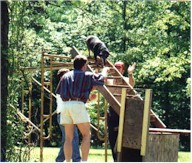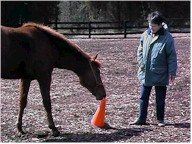Instead of an FAQ about Clicker Training, I would like to offer a slightly different perspective ... here are some Frequently Questioned Answers...
1) Yes, you do have to use a clicker, in order to fully understand this method of training. A word does not work as well as a clicker for marking the correct behavior. Trust me, I've done both.
People who suggest that abbreviated words work as well as a clicker simply haven't tried it. 2) No, it is not correct to use the clicker as a "keep going" signal. The clicker means "end of
behavior"The simplest solution is to use another signal as a "keep going" signal -- for instance, say "Keep going." <G>
3) You do not have to give a treat every time you click -- but until your dog is more experienced, it is not a good idea to do it too often. 4
) No, it is not a good idea to ellicit behavior with the clicker (or to shape illicit behaviors :) 5) Yes, you can teach classes with clickers -- they work better than non-clicker classes.
7) No, your 30+ years of dog training experience will not automatically help you with this. On the contrary. The more you refuse to jump in and "drink deep" , the more problem you will have with the nuances. 8
) You will not learn anything substantive about clicker training unless you actually do it. No
explanation or answer to your questions is going to help you, if you aren't willing to put in the hours of training and observing. If you are trying to learn this method through reading and
thinking, you will become very frustrated -- 9) Yes, there are limits to what you can do with a clicker
10) Yes, you can still use a choke chain if you want to. Using a clicker will not bar you from using aversives on your animal, if you choose to. It may give you a number of reasons not to,
however. Or, it may teach you how to decide when an aversive is justifiable. 11)If your dog is afraid of the clicker, it is invariably worth it to take the time necessary to fix the
problem.If a tiny little click will make your dog go belly up, you have a much bigger problem than "fear of clickers". The solution is to broaden your dog's repertoire and start teaching for the sake
of teaching. (Call it "learning, for the sake of mental health!") 12) A target stick is the best way to get a crossover dog to adjust to the new process.(See the
picture, above) . This was a quicky agility course, set up for Search and Rescue training by Dogs East. My dog, Megan is following a target stick through the course with no problem. It took her
exactly three trials to be able to do it with only my voice for guidance: once following the stick, once following my hand and once by voice -- and she was 12 years old at the time.She had just
completed the part of the obstacle that isn't in the picture - a set of 2x12's on a scaffold, leading out to nothingness, about 8 feet off the ground. )
13) You do have to obey the rules, but not "all of the rules, all of the time." There is a great
temptation to try to "follow the rules" of clicker training. Above all, this type of operant conditioning is dynamic. Each of the elements of learning may take a predominant position at any
time -- when you break the rules, you are merely using your grandmother's favorite butter knife as a screw driver -- not a good habit to get into, but it may be the right thing to do at the moment.
Feel free to experiment and then analyze the results of your efforts -- that's the key to becoming a fine clicker trainer.Use the animal's behavior as the proof of the pudding and you will stay on course. Home | Top | Seminars | Products | Articles | Clicker Training | Go Shopping! | E-mail to us! . |
 See #12, below
See #12, below 